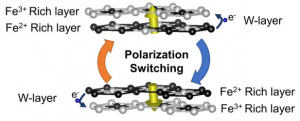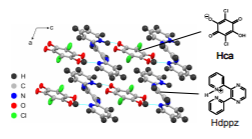~Seeing and manipulating ferroelectric materials~

Some crystals can distinguish between the right and left (or top and bottom) of the crystal itself. Can you think of a crystal with such a “polar” structure? Of course, if it is a “molecule” consisting of several atoms, you can give many examples of left-right differences. However, in crystals made up of Avogadro number of molecules and atoms, there are not many crystals that have polar structures. When nature produces crystals, it seems natural that the arrangement of atoms should be symmetrical without favoritism on either side.
However, if you find a crystal with such a polar structure and can vary its direction by external electric field, the crystal is given the specific name “ferroelectrics”. What are the characteristics of ferroelectrics? For example, when you change the direction of the polarity, the crystal structure also changes, and you can convert the electric field into a mechanical signal. Conversely, applying pressure to a crystal can convert it into an electrical signal. These properties are used as actuators and piezoelectric elements. In addition, the directional properties of ferroelectrics have been applied to memory, capacitors, and nonlinear optical elements, making ferroelectrics a key material that plays an important role in a wide range of modern industries.
In my laboratory, we are focusing on the following new ferroelectric materials that have been developed in recent years and are challenging not only to investigate their various properties but also to control new ferroelectric functions using laser pulses.

In some ferroelectrics, the difference between the left and right sides of a crystal is caused by “the arrangement of ions with different valence electrons. This type of ferroelectrics is called “electronic ferroelectrics,” and research on its development has been active in recent years. One candidate material is an iron oxide crystal with the composition LuFe2O4 proposed by Ikeda et al. of Okayama University (Ikeda et al., Nature 436, 1136 (2005)). Recently, we have discovered that a similar iron oxide (YbFe2O4) exhibits Second Harmonic Generation (SHG) for the first time. Furthermore, from tensor analysis of the observed SHG, we determined the polarization structure of this system and showed that its symmetry belongs to the monoclinic Cm. This result provides important evidence that this iron oxide system is electronic ferroelectrics.
This work was done in collaboration with the Ikeda Group of Okayama University and was published in Sci. Rep. 11, 4277 (2021) (Editors’ choice).

Recently, a series of organic cocrystals that exhibit high ferroelectricity in molecularly assembled crystals via hydrogen bonding has been found (e.g., Horiuchi and Ishibashi, J. Phys. Soc. Jpn. 89, 051009 (2020)). We have focused on Hdppz-Hca (di pyridinyl pyrazine-chloranilic acid) cocrystals, which exhibit ferroelectricity at room temperature and have attempted to control their ferroelectricity using an ultrafast laser pulse. When mid-infrared femtosecond pulses (maximum intensity of ~30 MHz/cm) with a fixed oscillating phase of the electric field were irradiated to the crystal, we found that the SHG intensity of the system enhanced by about 100% during the time the oscillating pulse was applied. This is caused by a temporal shift of the protons from their equilibrium position only during application of the oscillating electric field, which can be called the Floque state of the proton, and can be viewed as a new method of ultrafast ferroelectric switching.
This research was done in collaboration with Itatani Laboratory, Institute for Solid State Physics, University of Tokyo, and Horiuchi Laboratory, AIST. [APL Materials, 10, 090702 (2022) and J. Phys. Soc. Jpn. 88, 013705 (2019) (Editors’ choice).]
